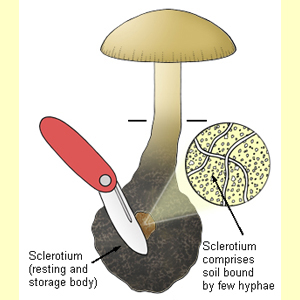
Sclerotia (and pseudosclerotia) act as a resting stage of the fungus. They are usually produced underground, and are often stimulated to produce fruit-bodies by fire.
See also pseudorhiza, where the stipe is elongated below the ground, but not expanded in diameter, and the stipe tissue in the underground portion is not significantly different in texture to that above the ground.
The pseudosclerotium is difficult to cut in half due to the presence of non-fungal material (hence the common name Stonemaker for some species of polypores which produce pseudosclerotia). If a cross section can be obtained, the cut surface usually looks similar to the surrounding substrate, and microscopic examination will show numerous soil particles or wood fibres. The outer surface of a pseudosclerotium is not differentiated, and it may be rough to touch due to soil particles.
Sometimes the stipe may continue through the pseudosclerotium.
A pseudosclerotium is rarely present in agarics, occurring in Austrolentinus, Neolentinus and Panus.
